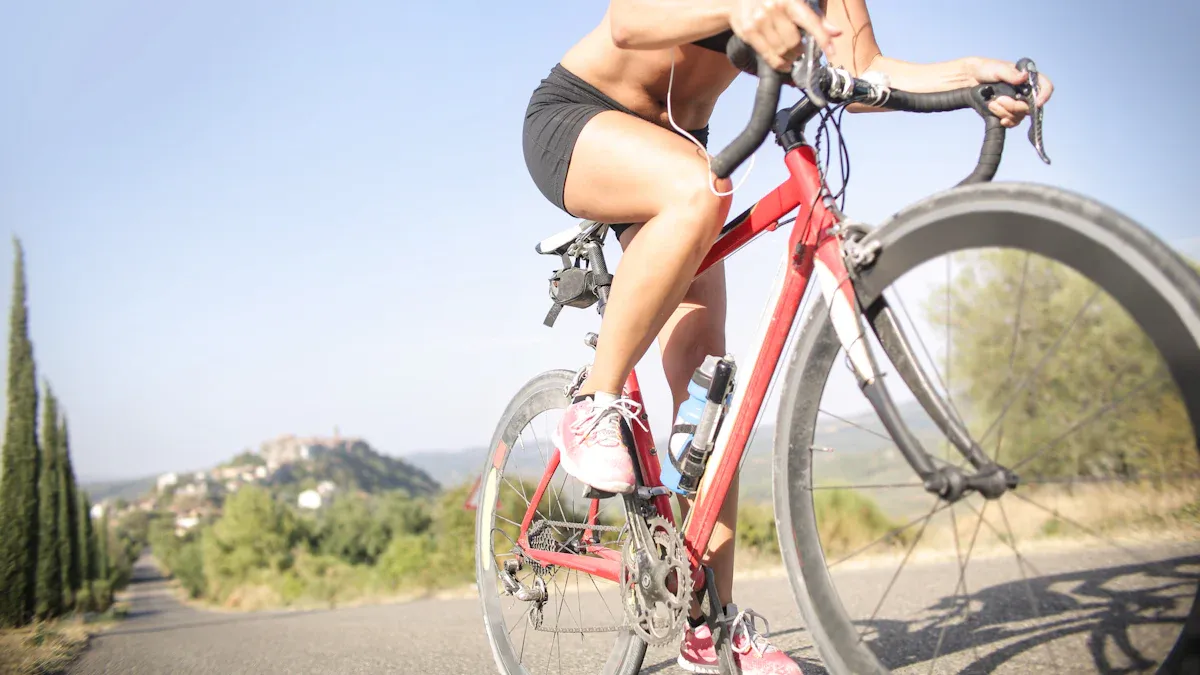
Looking for the right bike size can feel tricky, but a quick chart can help you get started. Check out this handy chart that matches your height with the recommended female bike frame size:
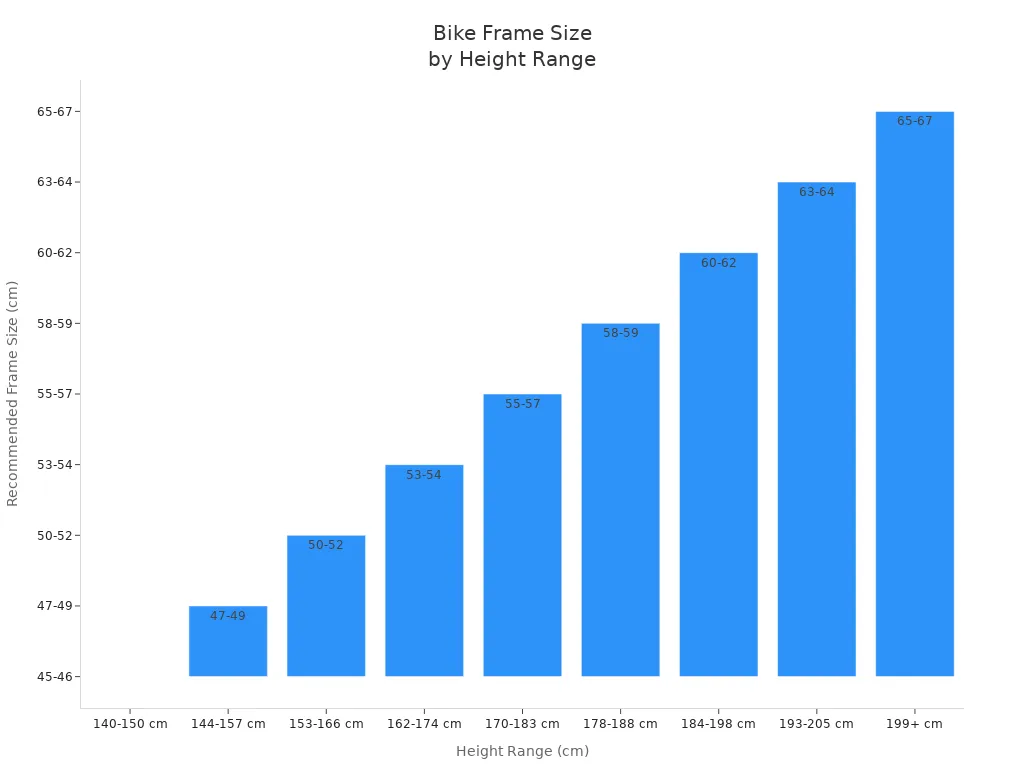
Getting the right bike size matters a lot for women. Studies show that female cyclists have different body shapes, like wider hips and different leg movements. If you ride a bike that does not fit, you might feel pain, risk injury, or just not enjoy your ride. This guide helps you find the perfect fit, so you can ride safely and comfortably every time.
Key Takeaways
Check your height and inseam to pick the right bike frame size for you.
Look at bike size charts first, but always try riding bikes in your size range to see which fits best.
Pick bike types and sizes that fit how you ride and your body shape. Try women-specific frames if you can.
Change the saddle height, handlebars, and other parts to make your bike more comfortable and easier to control.
Ask a bike expert for help with fitting when you can. This helps you ride safely and enjoy your bike more.
Female Bike Frame Size Chart

Women’s Bike Sizing by Height
Finding the right bike size starts with your height. Most bike brands use height as the main way to match you with a suggested frame size. You will see that many bike size charts use both inches and centimeters. Some brands use letter sizes like XS, S, M, and L. These sizes help you find a frame that fits your body and riding style.
You can use the following bike size chart to get a quick idea of what frame size matches your height. This chart covers road, hybrid, and commuter bikes. It also shows the most common frame sizes for women. If you want the best bike size for women, always check your height and inseam before you buy.
Bike Type | Frame Size (inches/cm) | Rider Height Range (feet/inches) | Rider Height Range (cm) |
|---|---|---|---|
Road Bike | 49-50 cm (X Small) | 5’0″ to 5’3″ | 152 to 160 cm |
Road Bike | 51-53 cm (Small) | 5’3″ to 5’6″ | 160 to 168 cm |
Road Bike | 54-55 cm (Medium) | 5’6″ to 5’9″ | 168 to 175 cm |
Road Bike | 56-58 cm (Large) | 5’9″ to 6’0″ | 175 to 183 cm |
Hybrid Bike | 47-49 cm (X Small) | 4’10” to 5’1″ | 147 to 155 cm |
Hybrid Bike | 50-52 cm (Small) | 5’1″ to 5’5″ | 155 to 165 cm |
Hybrid Bike | 53-54 cm (Medium) | 5’5″ to 5’9″ | 165 to 175 cm |
Hybrid Bike | 55-57 cm (Large) | 5’9″ to 6’0″ | 175 to 183 cm |
Hybrid Bike | 58-61 cm (XL) | 6’0″ to 6’3″ | 183 to 191 cm |
Commuter Bike | 13.5″ – 16″ | 4’10” to 5’6″ | 147 to 168 cm |
Commuter Bike | 16″ – 18″ | 5’6″ to 5’10” | 168 to 178 cm |
You can also check out this grouped bar chart for a visual look at the recommended women’s bike frame sizes for different height ranges and bike types:
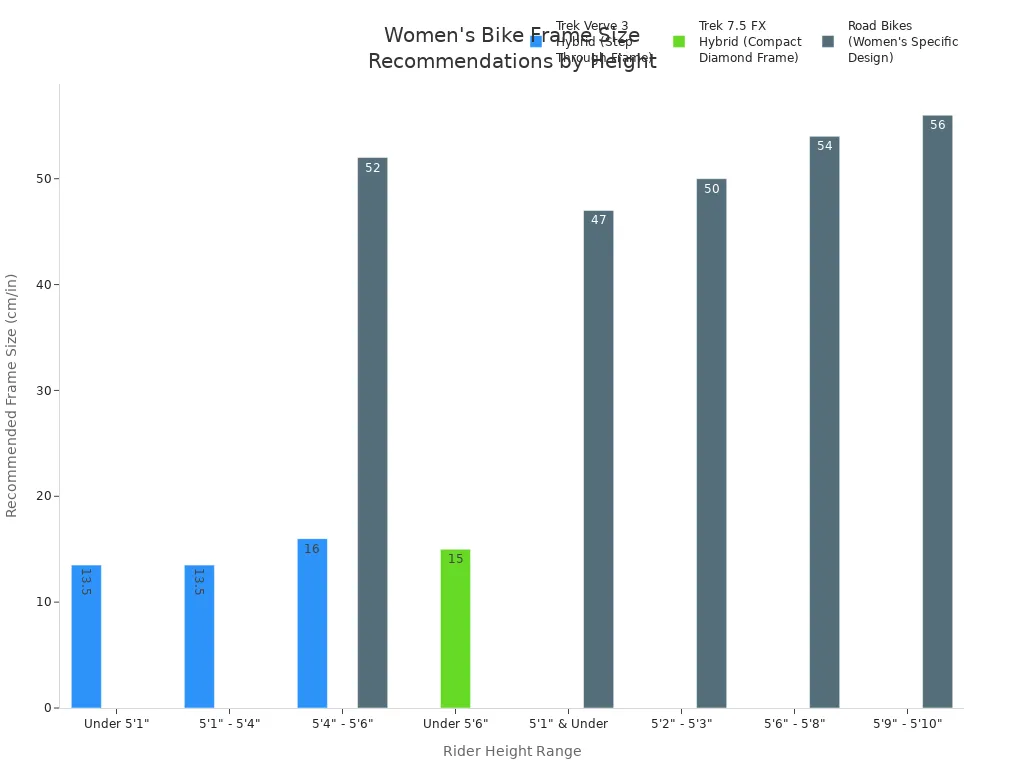
If you are looking for a women’s road bike size chart or a women’s mountain bike size chart, you will notice that the numbers are close, but the geometry and fit can feel different. Road bikes usually have a more stretched-out position, while mountain bikes are built for control and stability.
Tip: Always use your height as a starting point, but check your inseam for a more accurate fit. The best bike size for women often depends on both measurements.
Bike Size Guide for Road, Hybrid, and Commuter Bikes
You might wonder why there are so many bike size charts. Each bike type—road, hybrid, and commuter—has its own geometry. Road bikes put you in a lower, more forward position. Hybrid bikes give you a more upright ride. Commuter bikes focus on comfort and easy handling. These differences affect the suggested frame size for each type.
Here is a quick-reference women’s road bike size chart and women’s mountain bike size chart based on height:
Height (Feet/Inches) | Height (cm) | Road Bike Frame Size | Hybrid/Commuter Frame Size | Mountain Bike Frame Size |
|---|---|---|---|---|
4’10” – 5’1″ | 147-155 | 44-46 cm (XXS) | 13-14″ (XS) | 13-14″ (XS) |
5’1″ – 5’3″ | 155-160 | 47-49 cm (XS) | 15″ (S) | 15″ (S) |
5’3″ – 5’5″ | 160-165 | 50-52 cm (S) | 16″ (S) | 16″ (S) |
5’5″ – 5’7″ | 165-170 | 52-54 cm (M) | 17″ (M) | 17″ (M) |
5’7″ – 5’9″ | 170-175 | 54-56 cm (M/L) | 18″ (M/L) | 18″ (M/L) |
5’9″ – 5’11” | 175-180 | 56-58 cm (L) | 19″ (L) | 19″ (L) |
You can also use a bike size calculator to double-check your suggested frame size. Many bike shops and websites offer a bike size calculator that asks for your height and inseam. This tool helps you find the best bike sizes for women, especially if you fall between two sizes.
Wheel Size Recommendations for Petite and Average Women
Wheel size matters, especially if you are petite. For women around 5’0″ or shorter, 24″ wheels or 650c wheels on road bikes can make a big difference. These smaller wheels help you reach the ground and handle the bike better. If you are average height (about 5’1″ to 5’5″), you can use standard 700c wheels for road bikes or 26″ wheels for hybrids.
Rider Height Range | Road Bike Wheel Size | Hybrid Bike Wheel Size |
|---|---|---|
Petite (4’10” – 5’1″) | 650c | 24″ or 26″ |
Average (5’1″ – 5’5″) | 700c or 650c | 26″ or 27.5″ |
Very Petite (around 5’0″) | N/A | 24″ |
Note: If you are very petite, you might find that a juvenile bike with 24″ wheels fits you best. This is a practical and affordable option when custom bikes are not available.
Why You Should Try Bikes Within the Suggested Size Range
You might see a suggested frame size for your height, but your body proportions can change the fit. Women often have longer legs and shorter torsos than men. This means you might need a shorter top tube or a different handlebar width. Trying bikes within the recommended range helps you find the most comfortable fit.
Bike brands often use the same fork rake for many sizes, which can affect how the bike feels, especially for smaller frames. If you try a few sizes, you can see which one feels best for your reach, comfort, and control. Sometimes, a professional fitting or a test ride will help you find the best bike size for women.
Tip: Even if the bike size chart says you fit a certain frame size, always test ride if you can. Adjustments to the seat, handlebars, and stem can help you fine-tune your fit.
You can also check out this grouped bar chart for another look at recommended bike frame sizes for women by height and bike type:
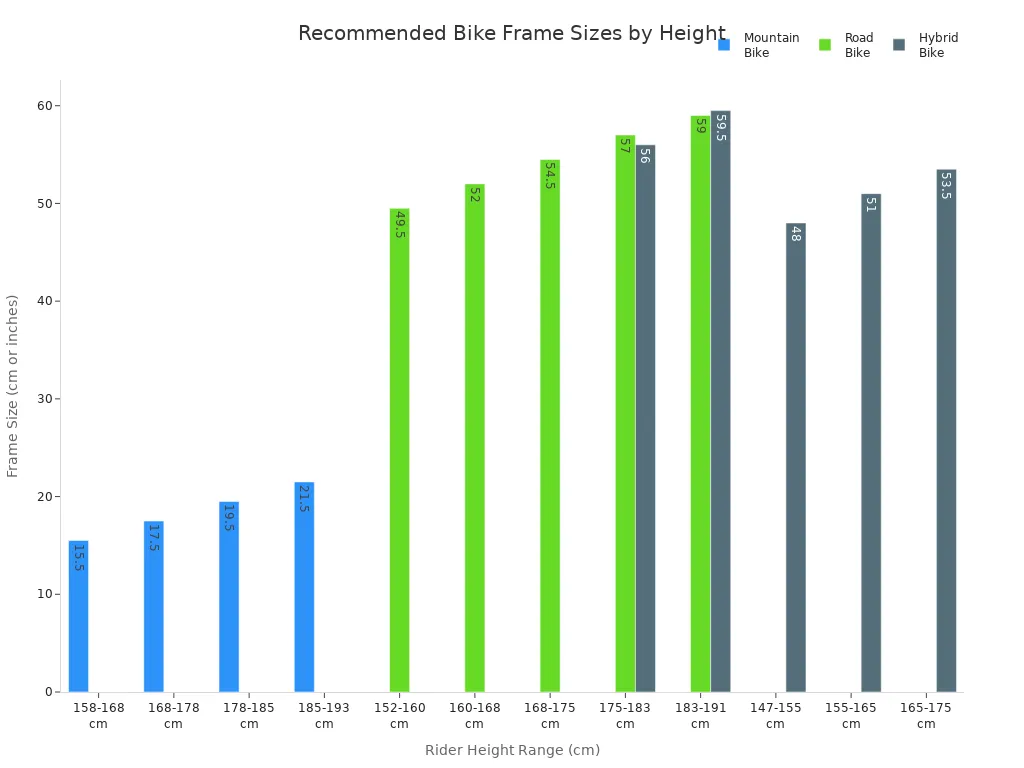
If you want the best bikes for women, focus on comfort and fit, not just the numbers. Women’s bike sizing is about more than just height. Your inseam, reach, and riding style all play a part. Use the bike sizing guide, try a bike size calculator, and always test ride before you buy. This way, you will find the female bike frame size that works for you.
How to Measure for the Right Bike Size

Measuring Height and Inseam
Getting the right bike fit starts with two simple measurements: your height and your inseam. You want to measure your height first. Stand straight against a wall with your shoes off. Use a tape measure to check the distance from the floor to the top of your head. Write down your height in inches or centimeters.
Next, measure your inseam. This step helps women find a bike that fits their legs and gives enough clearance. Stand with your feet about shoulder-width apart. Place a book between your legs, pressing it up snugly. Measure from the top edge of the book to the floor. This number is your inseam. Many bike shops use inseam length to match you with the right frame size, especially if your rider height falls between two sizes.
Tip: Always measure your inseam and height before using a bike size calculator. This helps you get the most accurate result.
Tips for Accurate Measurement
You want to avoid common mistakes when measuring for bike frame size. Many women rely only on height, but inseam matters just as much. If you skip the inseam, you might end up with a bike that feels too tall or too short. Some women forget to check reach and stack measurements, which can lead to discomfort. Women’s bikes often have shorter top tubes and narrower handlebars to fit female body shapes.
Here are some tips to help you get the best fit:
Measure both height and inseam before using a bike size calculator.
Try bikes within your suggested rider height range. Test rides help you feel the difference.
Pay attention to bike geometry. Women’s bikes may have sloping frames and wider saddles for comfort.
Adjust saddle height and handlebar position. Small changes can make a big difference.
Get a professional fitting if you can. Experts help women avoid sizing mistakes and find the perfect bike.
Your inseam matters because it affects standover height and how easily you can get on and off the bike. If your inseam is shorter or longer than average for your height, you may need a different frame size. A bike size calculator uses both measurements to suggest the best fit for women. When you measure carefully, you set yourself up for a comfortable and safe ride.
What Size Bike Should I Get?
Using the Bike Size Guide
You want to find the right bike size for your body. The bike size chart is your starting point. First, measure your height and inseam. Stand straight without shoes and use a tape measure. For your inseam, stand with your feet apart and measure from the floor to your crotch. These numbers help you match your rider height to the frame size on the bike size chart.
Most bike size charts show frame size in centimeters or inches. Some use XS, S, M, or L. Look for a chart that matches your height and inseam. Women’s bikes often have shorter top tubes, sloping frames, and narrower handlebars. These features help you get a better fit.
Here’s how you can use the bike size guide to find the best fit for you:
Check your height and inseam against the bike size chart for your chosen bike type.
Look for women’s-specific frames if you want a bike that matches your body shape.
Think about your torso and arm length. If you have a longer torso or arms, you may need a frame with a longer top tube.
Test ride bikes in your recommended frame size range. You will feel the difference in comfort and control.
Ask for a professional bike fitting if you want expert advice.
Tip: Comfort matters more than style. Always choose the right bike size for your body, not just what looks good.
If you want to know how to check if a bike is the right size, stand over the bike. You should have at least 2 inches of clearance between the top tube and your body. Reach for the handlebars. Your arms should feel relaxed, not stretched or cramped. Adjust the saddle and handlebars to fine-tune your fit.
Choosing Between Sizes
Sometimes you fall between two frame sizes on the bike size chart. Don’t worry. You have options. If you pick the smaller frame size, you get a more dynamic ride. The bike feels nimble and quick. If you choose the larger frame size, you get more comfort, especially on long rides.
Here’s what you can do if you are between sizes:
Try both frame sizes. See which one feels better for your riding style.
Pick the smaller frame size if you want a sporty, responsive bike.
Choose the larger frame size if you want a relaxed, comfortable ride.
Remember, final adjustments like saddle height and handlebar position can improve your fit.
Visit a bike shop for a professional fitting if you have back or leg issues.
Bike sizing is not an exact science. Your comfort and riding style matter most. Manufacturers give recommendations, but your personal fit is unique. Test rides and expert advice help you find the right bike size.
Fit for Petite or Tall Women
If you are petite or very tall, finding the right bike size can feel tricky. Women’s-specific frames help a lot. These bikes have shorter top tubes and lower standover heights. You get a better fit and more control.
For petite women:
Look for bikes with smaller frame sizes on the bike size chart.
Try bikes with 24″ or 650c wheels for easier handling.
Choose women’s-specific saddles. Wider saddles support your pelvic bones and reduce pressure.
Pick handlebars that match your shoulder width. Narrower handlebars (around 380 mm) fit better.
For tall women:
Check the bike size chart for larger frame sizes.
Make sure the top tube is long enough for your torso and arms.
Adjust the stem length and handlebar height for a comfortable reach.
Test ride different models, including unisex frames, to find the best fit for you.
If you have unique body proportions, measure your inseam, torso, and arm length. Try different frame sizes and bike models. Adjust components like the saddle and handlebars. Women’s bikes often let you swap parts for a custom fit.
Note: If you feel discomfort after choosing a recommended frame size, adjust the saddle position, height, and tilt. Try different saddles and handlebar setups. Wear bike shorts and use chamois crème to prevent chafing. Keep good hygiene and shower after rides. If pain continues, seek a professional bike fitting.
The right bike size makes every ride safer and more fun. Use the bike size chart, measure carefully, and test ride before you buy. Your comfort and safety come first.
Additional Women’s Bike Sizing Tips
Reach and Standover Height
When you look for the right bike size, you might hear a lot about standover height and reach. Standover height means the space between the top tube and your body when you stand over the bike. For women with shorter legs, standover height helps you stop and stand safely. You can lean the bike to one side if you need more clearance. Standover height matters more for mountain bikes and off-road riding. On road bikes, you can manage with less clearance, but it still helps with comfort and safety.
Reach is the distance from the saddle to the handlebars. This part affects how you sit and pedal. If the reach is too long, you stretch too much and feel tired. If it is too short, you feel cramped. Women often have shorter torsos and longer legs, so a bike with a shorter top tube gives a better fit. Tire size also changes standover height. Bigger tires raise the bike, so check this when you pick your bike.
Remember: Reach is more important than standover height for overall comfort. You want a bike that lets you ride in a natural position and pedal easily.
Adjustability and Test Riding
You can adjust many parts of your bike to get the right bike size and fit. Here are some ways to make your bike fit your body:
Change the saddle height so your legs almost straighten with a slight bend.
Move the saddle forward or back to match your sit bones and weight.
Adjust the handlebar height and angle for a relaxed reach.
Swap handlebars or stems to fit your torso and arm length.
Pick brake levers that fit your hand size.
Try smaller frames or step-through designs if you are shorter than average.
Professional bike fitting helps you get the best setup. Experts look at your body and riding style. They adjust the saddle, handlebars, and pedals. You can test ride the bike and feel the changes right away. Fitting includes checking your position on and off the bike. You get more comfort, better pedaling, and less pain. Follow-up sessions help you keep the proper bike fit as you ride more.
Here is a quick table showing what you can adjust for a better fit:
Bike Part | What You Can Adjust | Why It Matters |
|---|---|---|
Saddle | Height, tilt, position | Leg extension, comfort |
Handlebars | Height, angle, reach | Arm position, control |
Brake Levers | Distance to grips | Hand size, safety |
Frame/Wheels | Size, step-through design | Standover height, mounting |
Tip: Always test ride before you buy. You will feel if the bike fits your body. Professional fitting makes sure you get the right bike size and enjoy every ride.
Finding the right bike frame size helps women ride with comfort and confidence. Start by picking your bike type, then measure your height and inseam. Use a bike size guide or chart to match your numbers. Here’s a quick look at the steps:
Measure your height and inseam.
Check the size chart for your bike.
Get a professional fitting if you want the best comfort.
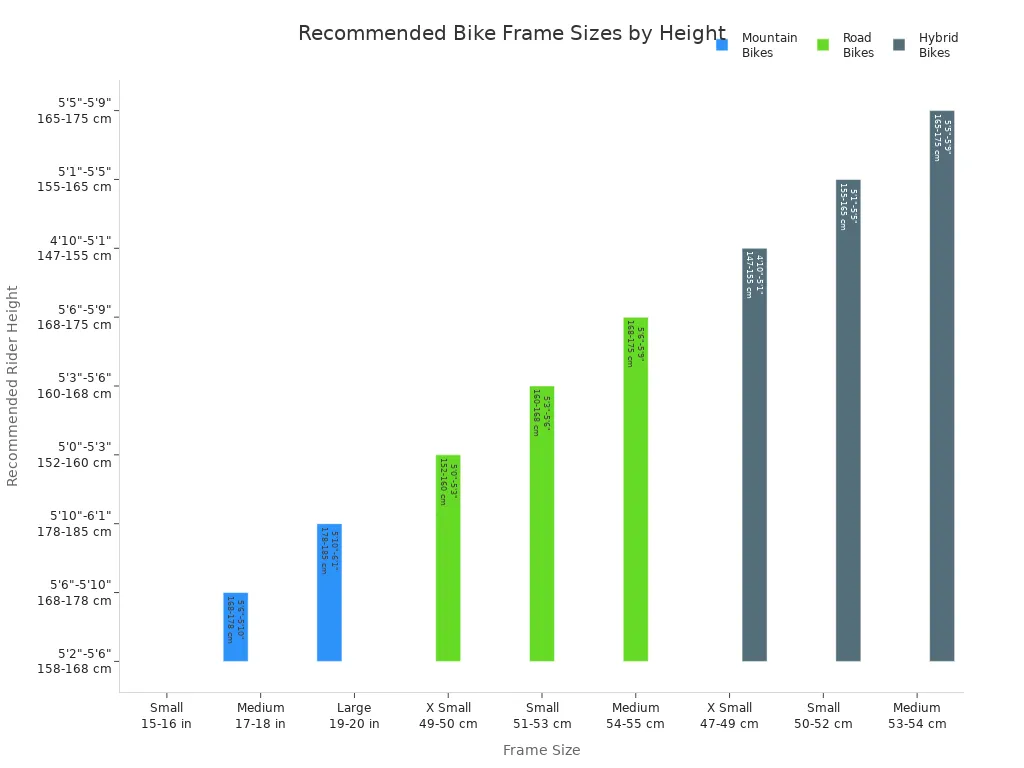
Remember, women who use these steps avoid pain and ride safer. Comfort and safety always come first!
FAQ
What if my height falls between two bike sizes?
You can try both sizes. The smaller frame gives you a sporty feel. The larger frame feels more relaxed. Test ride each one. Adjust the saddle and handlebars for comfort.
Do women need a women’s-specific bike frame?
You might find women’s-specific frames more comfortable. These bikes often have shorter top tubes and narrower handlebars. If you feel good on a unisex frame, that works too. Always choose what fits your body best.
How important is inseam measurement for bike sizing?
Your inseam helps you pick the right frame size. It affects standover height and leg extension. Measure your inseam before you buy. This step makes your ride safer and more comfortable.
Can I adjust a bike if the frame size isn’t perfect?
Yes! You can change the saddle height, move the handlebars, or swap out parts. Small adjustments help you get a better fit. A bike shop can help you make these changes.
What wheel size should petite women choose?
Petite women often do better with 24″ or 650c wheels. These sizes make it easier to reach the ground and handle the bike. Ask your local shop for options that match your height.
See Also
Using A Bike Frame Size Chart To Get Perfect Fit
Step-By-Step Guide To Measure Height And Inseam Correctly
Understanding Racing Bike Frame Sizes For All Cyclists
Simplifying Large Mountain Bike Frame Sizing And Geometry
Determine Your Ideal Bike Frame Size Using Height And Inseam
